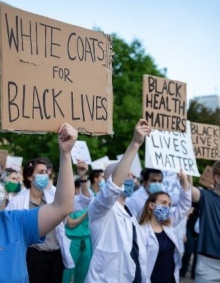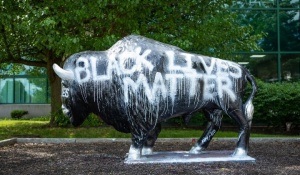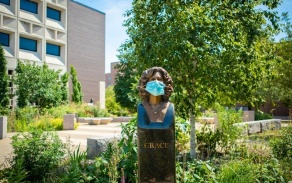Student Reflections on Spring 2020
Alison Garcia, BA History, June 3, 2020
I would have never imagined that this is how my four years at the University at Buffalo would have concluded. As I moved on from this institution and entered the work force post an already disturbing time in history due to the COVID-19 pandemic, George Floyd’s murder occurred.

UB’s “White Coats for Black Lives” March on June 6, 2020
George Floyd was a 59-year-old African American man who was a victim of police brutality over a claimed falsified check. Four police officers, including Derek Chauvin, participated in his arrest, which ultimately lead to oppressive force that eventually killed him. His cause of death was asphyxiation from sustained pressure. Protests erupted all over the United States, this included looting, riots, violence, but also, unity between peaceful protesters and some police offices.

Paint-a-Bull, June 2020
As a historian, I felt I needed to be part of the protest, to be a part of the right side of history. And while I was figuring out how to be an active participant in helping such a pivotal time, I almost forgot I have elderly at home, while a very aggressive national pandemic is still occurring. Thus, for now the best thing for me to do is to share and repost remotely what I can do for George Floyd’s cause and the BLM movement.
This is how I am entering the work force and adult life. And as a person of color, I am petrified. One of the most prevalent ideas that I gained from being a historian at UB is the importance of learning our history. From crime and punishment courses and the African American Studies Department, I learned about the resilience people of color have shown during tumultuous times in history. The energy this time around feels different, and I know that the end of the tunnel, positive, tangible change will be amongst us. I think as a nation we are all a little wary about all these very scary events happening at once, but we are much stronger than what we fear,and I first handedly learned that at UB.
Michael Barcomb, MA History, June 30, 2020

UB uses signs and other forms of awareness to promote mask use and social distancing on campus
There are some parallels between the practice of reprisal killings in warfare and the psychology surrounding those Americans who refuse to comply with COVID-19-related measures as a matter of principle. The function of the reprisal killing is to nullify both the practical destructive advantage of one group’s resistance to another dominant group and the enticement to further insurrection that resistance exerts upon non-belligerent members ofthe repressed population. Since their implementation, COVID-19-related regulations have been protested and actively defied by sections of the American population. This behavior is driven not only by simple ignorance, but by the perception that state governments are acting tyrannically in having taken such sudden and extensive steps. During a pandemic, the dominant force, ostensibly the state, lacks control over the disease’s destructive power, which is internal and invisible. The state is therefore able to legitimize its decisions made in the name of public welfare through fear and violence for which it is not accountable.
In a pertinent section of Michel Foucault’s Discipline and Punish, Foucault explores how biological threats cause an alignment of individual and authoritative interests that is conducive to authority’s diffusion and internalization. He presents the historical example of a plague-stricken European town in the seventeenth century; there, compliance was compelled by a feeling of death’s certainty were one to violate isolation orders, a feeling generated both naturally by the plague, and artificially, by armed government officials who reserved the right to execute noncompliers. The “gaze” that observed, documented, and ensured the stationary, atomized state of the town’s inhabitants was primarily that of these officials. While Foucault asserts that this situation was not “a massive, binary division between one set of people and another,” its dynamic was more stratified in terms of real power concentration than today’s. (Foucault 195-198)
In the absence of such direct coercion and supervision by state institutions, conflict has arisen between sections of the population that perceive a hostile binary relationship between government and citizen, and the compliant majority who more accurately represent the role of contemporary society at large in realizing aims that, while they coincide with the government’s in this instance, are reflections of society’s dominant undercurrents. It is important to note that proponents of COVID-19-related regulations usually express more concern for others’ health than their own, which can be attributed to COVID-19’s discriminate severity. This fact has yielded a reprisal-killing mentality: civilian proponents of precautions, whose zeal and initiative projects official authorities’ influence further and more efficiently than Foucault’s town’s partial reliance on physical law enforcement, attempt to nullify noncompliers’ pride in defying death and resisting perceived state tyranny by citing the potential infection risk they pose to non-participants in doing so, and by arguing that any resultant deaths are their personal responsibility. In this way, the frustration of Americans who oppose social distancing laws (excluding those who believe the pandemic is a hoax), stems partly from an individualistic outrage over their being subordinated to society and denied the freedom to directly confront the enemy. This issue is compounded by the rational nature of most COVID-19-related precautions, in that some among said Americans feel precautions to be acts of submission even when performed on one’s own initiative rather than in response to social and governmental coercion. They subsequently exhibit an absolute and irrational contempt for caution that is indefensible, but the indefensibility of this particular behavior easily lends itself to an impression of the validity of the collective will over individuals’ case-by-case rationalizations that may affect more controvertible social and political questions in the future.

Bronze Buffalo on UB North Campus masks up to raise awareness of UB’s COVID-19 safety procedures